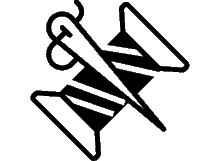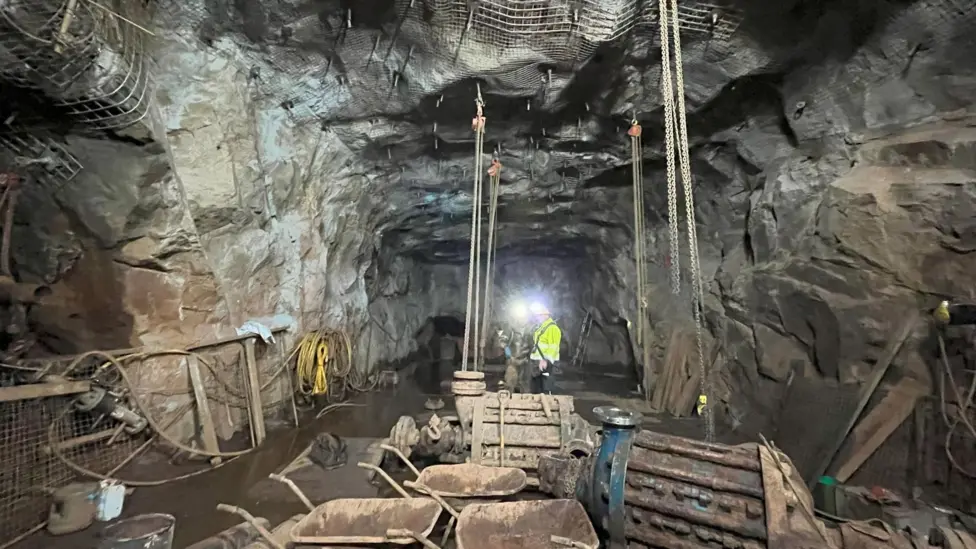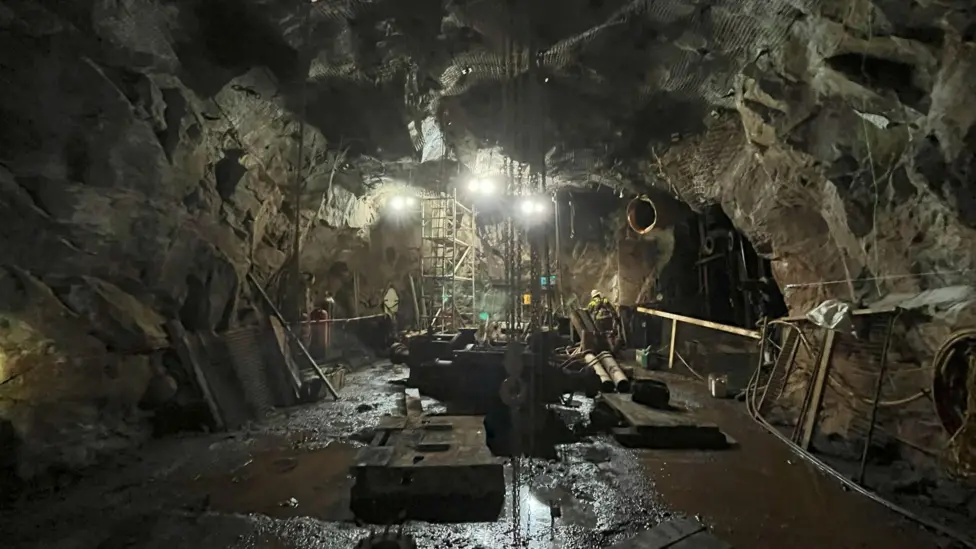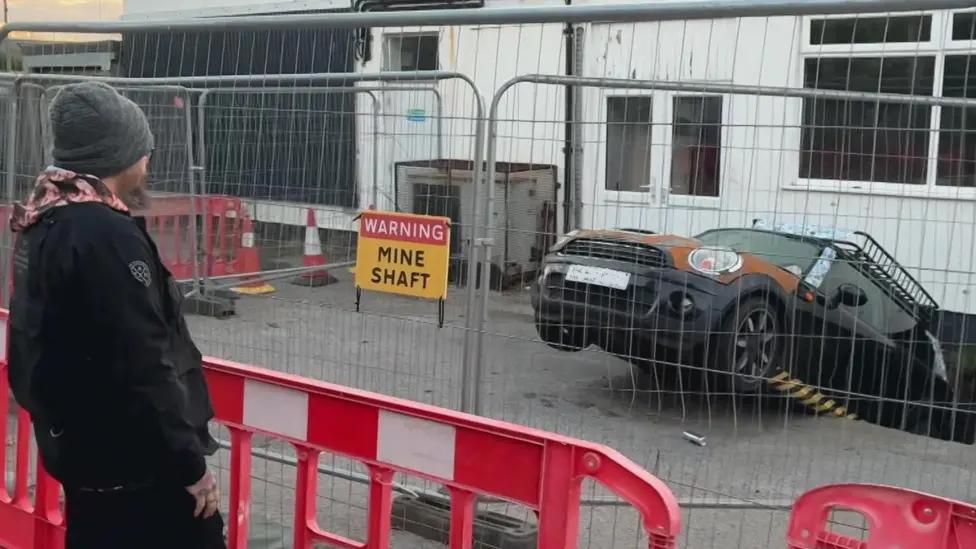| Mining in Cornwall Posted by TonyK at 15:58, 31st October 2024 |     |
Given that Cornwall is the county that in some ways gave the world hard rock engineering & mining, it's surprising that an underpass wasn't a contender for that one. Heights there are somewhat in favour and its something that would have offered a straightforward high throughput walking route between the new down side car park and the bay platform.
Mark
Mark
I can tell you that an underpass was seriously considered but ruled out quite a long time ago now.
As a former (long time back) tin miner, I consider another worry would have been stopping the digging if evidence of copper, tin or worst of all lithium had been found.
| Mining in Cornwall Posted by Mark A at 18:19, 31st October 2024 |     |
This put me in mind of the sight of that mineshaft, informally capped with lengths of old rail line, nestling close alongside one of the piers of the viaduct at Barrepta Cove.
Mark
| Mining in Cornwall Posted by TonyK at 19:01, 31st October 2024 |     |
| Mining in Cornwall Posted by Oxonhutch at 20:06, 31st October 2024 |     |
380 fathoms deep...
Yes old mines used to measure themselves in fathoms. One I worked on, (1.5 miles down: 1320 fathoms)) spanned the metrication change-over, and the older production figures were quoted in square fathoms. I imagined this to be 6 foot by 6 foot, but no: it was a square yard! Three squared is not 3 + 3

| Mining in Cornwall Posted by TonyK at 17:26, 4th November 2024 |     |
380 fathoms deep...
Yes old mines used to measure themselves in fathoms. One I worked on, (1.5 miles down: 1320 fathoms)) spanned the metrication change-over, and the older production figures were quoted in square fathoms. I imagined this to be 6 foot by 6 foot, but no: it was a square yard! Three squared is not 3 + 3

Levels at South Crofty were still fathoms when I was there, the ones still in use being from 212 to 380 at the time. It seems the levels continued to as low as 470 fathoms after that, until closure in 1998. The mine is in the process of being reopened. I still have my helmet (issued 1974) but will not be asking for my job back.
| Mining in Cornwall Posted by Chris from Nailsea at 17:57, 4th November 2024 |     |
Well done, both of you: I couldn't have coped with that - claustrophobia.

| Mining in Cornwall Posted by TonyK at 20:26, 4th November 2024 |     |
Well done, both of you: I couldn't have coped with that - claustrophobia. 

Most of the underground workings were reasonably spacious apart from anything newly drilled and blasted - I'm over 6' (or one fathom if measured from top down), but seldom had to stoop. The stopes were wide enough for a railway, battery powered apart from the very lowest level, which was diesel. On afternoon shifts, I used to drive the electric locos back to the cage for return to surface for a change of batteries and deliver them back where I had found them - if I could remember where that was. I believe that dumper trucks will be used instead of rail when the mine reopens. I found some pictures in a local news report - this would definitely add interest to St Erth station.
| Re: Mining in Cornwall Posted by Oxonhutch at 21:43, 4th November 2024 |     |
Seems like what I was reacting to has disappeared!
| Re: Mining in Cornwall Posted by Oxonhutch at 21:49, 4th November 2024 |     |
Well done, both of you: I couldn't have coped with that - claustrophobia. 
Most of the underground workings were reasonably spacious apart from anything newly drilled and blasted - I'm over 6', but seldom had to stoop.
Like TonyK, I never had to stoop so had no feeling of ill-ease on my job. I used to travel further to work than my father - and he travelled horizontally.
Invited down the father-in-law's coal mine, on the other hand, was a different kettle of fish. Slithering along the 2 foot high muddy stope like a serpent, I felt the weight of the mountain pressing upon my back - I think he had sent me to the thinnest coalseam on the pit!
I had to lie on my back in the warm slime and close my eyes - and breathe steadily - to regain my composure. If you drive a steam engine, think of the poor b****r digging your fuel!!
| Re: Mining in Cornwall Posted by Noggin at 16:10, 6th November 2024 |     |
380 fathoms deep...
Yes old mines used to measure themselves in fathoms. One I worked on, (1.5 miles down: 1320 fathoms)) spanned the metrication change-over, and the older production figures were quoted in square fathoms. I imagined this to be 6 foot by 6 foot, but no: it was a square yard! Three squared is not 3 + 3

At the risk of being pedantic, is it not four square yards or 36 square feet?
| Re: Mining in Cornwall Posted by TonyK at 17:43, 6th November 2024 |     |
Yes old mines used to measure themselves in fathoms. One I worked on, (1.5 miles down: 1320 fathoms)) spanned the metrication change-over, and the older production figures were quoted in square fathoms. I imagined this to be 6 foot by 6 foot, but no: it was a square yard! Three squared is not 3 + 3

At the risk of being pedantic, is it not four square yards or 36 square feet?
One of the mine captains gave me a requisition chit for "Oylskin jaquette", and another gave up on trying to spell "corrugated" and ordered "wiggly steel" instead. Either could look at a blank wall or rock at the end of a level in the mine and tell you instantly how long it would take to drill, how much explosive would be needed, how much rock would result and so on, and if I ever found myself stuck on Bodmin Moor in bad weather, I would rather have one of them with me than my accountant. Ask them about a square fathom, though, and my guess is they would use an obscure Cornish expression not usually heard in polite company, then get on with something else.
| Re: Mining in Cornwall Posted by stuving at 18:17, 6th November 2024 |     |
380 fathoms deep...
Yes old mines used to measure themselves in fathoms. One I worked on, (1.5 miles down: 1320 fathoms)) spanned the metrication change-over, and the older production figures were quoted in square fathoms. I imagined this to be 6 foot by 6 foot, but no: it was a square yard! Three squared is not 3 + 3

At the risk of being pedantic, is it not four square yards or 36 square feet?
I fear it's worse than that - and that a square fathom is in fact a volume measure: 8 cubic yards. After all, isn't a cube a square sort of thing?
| Re: Mining in Cornwall Posted by Mark A at 18:41, 6th November 2024 |     |
Well done, both of you: I couldn't have coped with that - claustrophobia. 

Most of the underground workings were reasonably spacious apart from anything newly drilled and blasted - I'm over 6', but seldom had to stoop. The stopes were wide enough for a railway, battery powered apart from the very lowest level, which was diesel. On afternoon shifts, I used to drive the electric locos back to the cage for return to surface for a change of batteries and deliver them back where I had found them - if I could remember where that was. I believe that dumper trucks will be used instead of rail when the mine reopens. I found some pictures in a local news report - this would definitely add interest to St Erth station.
Thanks for the link to the photos. I was lucky enough to go on an underground tour of Geevor, though in sad circumstances as the mine was selling underground tours in an unsuccessful attempt to raise money to keep the pumps running. Much to see, and a strong sense, underground, of the warmth and the sense of space (plenty of headroom helped with that, and the rock was very competent, there was no sense of vast weights of strata needing to be handled carefully...)
Mark
| Re: Mining in Cornwall Posted by Oxonhutch at 20:21, 6th November 2024 |     |
At the risk of being pedantic, is it not four square yards or 36 square feet?
Indeed! I am as pedantic as you in this matter hence my disquiet at the inappropriate terminology used to describe the actual unit of area. To address Stuving's comments: my mine was a gold mine in old sedimentary rocks, with gold bearing 'reefs' of variable thickness. Mining contracts (that determine pay) were on the basis of area irrespective of thickness.
The metric 'contract' unit was the centare - one hundredth of an are (pronounced 'air' - it being 10 by 10 metres or 100 square metres): i.e. one centare being one square metre. The hectare of today's field measurements being a hundred ares, or 10,000 square metres.
Now, I had inherited a mine publication on imperial to metric conversions dating from the early 1970s. There it gave the area conversion from square fathoms to centares. The square fathom turned to to be smaller than the square metre (centare) and a calculator showed that irrespective of what the unit was called, it was in fact a square yard. I reckon the miners of old took 3 x 3 feet to be 3 and 3 - hence six - and therefore a square fathom. Bit like an "Oylskin jaquette".
| Re: Mining in Cornwall Posted by stuving at 23:49, 6th November 2024 |     |
I take it the source of this usage was the need to measure how much material had been mined, for estimating the amounts of useful ore and recovered metal, and also for workers' payments. For that, you multiply the width worked by the distance, and they might customarily both be in fathoms. To get a true volume you would multiply by the height of the working as well, but that's not going to vary so was left out. As it happens, for a lot of mines this height is about six feet! From the comments above that was so in Cornish mines, and I think in South Africa too. If you cut a greater height than that you just didn't get paid for doing it, but that's your problem.
While other meanings may have come in more recently, here's an older example. In reports of the flooding at Porkellis United Mines on 24th August 1858, I found the volume of water and "slime and refuse from the stamps" that entered the mine given in square fathoms. Here, a real volume is called for, and there is no obvious value of working height to assume. And the number given does look very like length x breadth x depth in fathoms.
If you want an even bigger puzzle, I have come across a few references to square cubic fathoms ...
| Re: Mining in Cornwall Posted by Mark A at 08:09, 7th November 2024 |     |
I'd forgotten the length of a fathom. Reminded of it by the discovery that the name comes from an old word meaning 'Outstretched arms'.
Mark
| Re: Mining in Cornwall Posted by CyclingSid at 14:57, 7th November 2024 |     |
gave up on trying to spell "corrugated" and ordered "wiggly steel" instead
In Northern Ireland it was known as wriggly tin, at least tinners know which metal is which.
old word meaning 'Outstretched arms'
as with the sailor measuring the depth with a lead line.| Re: Mining in Cornwall Posted by Oxonhutch at 17:11, 7th November 2024 |     |
old word meaning 'Outstretched arms'
as with the sailor measuring the depth with a lead line.Now that makes sense! Maybe wrapping ones hands around a square yard could be the derivation of the square fathom or the surveyors fathom stick could be folded in the middle.
| Re: Mining in Cornwall Posted by TonyK at 19:57, 10th November 2024 |     |
old word meaning 'Outstretched arms'
as with the sailor measuring the depth with a lead line.
Now that makes sense! Maybe wrapping ones hands around a square yard could be the derivation of the square fathom or the surveyors fathom stick could be folded in the middle.
Every day is still a learning day!
| Re: Mining in Cornwall Posted by TonyK at 20:28, 10th November 2024 |     |
old word meaning 'Outstretched arms'
as with the sailor measuring the depth with a lead line.
Now that makes sense! Maybe wrapping ones hands around a square yard could be the derivation of the square fathom or the surveyors fathom stick could be folded in the middle.
Every day is still a learning day!
I take it the source of this usage was the need to measure how much material had been mined, for estimating the amounts of useful ore and recovered metal, and also for workers' payments. For that, you multiply the width worked by the distance, and they might customarily both be in fathoms. To get a true volume you would multiply by the height of the working as well, but that's not going to vary so was left out. As it happens, for a lot of mines this height is about six feet! From the comments above that was so in Cornish mines, and I think in South Africa too. If you cut a greater height than that you just didn't get paid for doing it, but that's your problem.
It's been half a century, but I'm pretty sure we were paid based on weight of ore removed, although it could just as easily have been volume as the end result in the pay packet would have been the same. All ore, whichever level it was dug, found its way to the lowest level, then 380 fathoms by being dumped through ore passes. At the bottom, it was loaded into railed trucks, much bigger than those on the levels, hauled to the shaft, then hoisted to the surface in a surprisingly slick operation that saw a load lifted practically every two minutes. I believe there is now a continuous road all the way down for dumper trucks, finished after I left, and that the new operation will bring ore to the surface in these.
We were all paid a fairly modest wage every week, with a fortnightly bonus. Every employee got "tin bonus" based on the ore mined rather than the tin produced. The Great Lode through which the mine ran held a pretty high concentration of tin, reasonably evenly spread, so it didn't really matter how big the drive was, that being determined by safety. The standard "end" was about 6 feet square. The drillers would drill a pattern of holes, the blasters would stuff these with explosives (Mr Nobel's finest back that, taken down in the cage in metal rail boxes, sometimes with me sat on top), the muckers would shift the rubble into the trucks, to be shifted by the trammers, and each would be paid a further bonus based on length drilled for drillers and blasters, weight/volume shifted for muckers and trammers. I was a cageman, ferrying men, machinery and materials up and down, and got some sort of bonus cobbled together under an old arrangement, which paid me a lot more than I had earned before, or would earn again for about the next 8 years. Output rose steadily in the weeks leading up to Christmas. Carpenters, plumbers, electricians and anyone else who worked underground had similar arrangements.
The level captain had his own little office hacked into the side of the level, and a bit like the croust seat in the photographs. As the mine grew, he needed a new one nearer the end, and I recall him negotiating bonus terms with the drillers for his new sumptious suite.
| Re: Mining in Cornwall Posted by Mark A at 21:30, 10th November 2024 |     |
This is fascinating, thanks for posting it.
Mark
| Re: Mining in Cornwall Posted by Oxonhutch at 21:32, 10th November 2024 |     |
Interesting that the terms used in Cornwall were nearly the same as that used on the Rand. A colleague of mine had the surname of José and I asked if that was Spanish derived - and he said no, it's a well founded Cornish name. His father was a retired Section Manager on our mine with a daughter named Barbara - after the patron saint of miners. It turned out that the survivors of the Spanish Armada, shipwrecked off the Cornish coastline were sent as slaves down the mines rather than the traditional slaughter of the day. They thus became totally integrated into the local industry.
The miners with blasting certificates were called Contractors (paid on the basis of area mined). The muckers were Night-shift Cleaners and the ore was handled in much the same way - descending to the bottom of the shaft to be rapid wind (as in wind a clock) to surface. We had Shift Bosses that oversaw the miners, led by Mine Captains who had charge of a level with a depth measured in 100s of feet. Thus 64 level = 6400'.
Tony's job of cageman was called an Onsetter below ground and a Banksman on surface - the latter was the boss of the shaft system. Strict hierarchy was determined by rank that was almost military in structure with everyone having a different colour of hat depending on one's grade in the system. All except service personnel like surveyors and geologists (me) who had white hats irrespective of rank. Thus although I changed in the Mine Captains' change house, they had yellow hats and could travel as freely as they liked (out ranking anyone else normally underground) I, who had a job to do on surface after having changed, had to beg and plead to be able to leave before shift change over. Thus the Onsetter (Cageman) was my friend to be cultivated carefully.
As Tony will probably remember, all cage movements were telegraphed on a bell-code system (rather like manual signalboxes) and winds for men (signalled 3-3-3) were done a lot slower and safer than materials. Getting out one time, I was told I could only leave on a material wind. It was the scariest trip ever - door only half closed and a double speed wind - heaven knows what would have happened if the winding motors had tripped out (suddenly stopped)- which involves zero gravity free-fall followed by violent yo-yo motions in a steel box. I never did it again.
The Banksman's eyes on me exiting were a sight to behold. Sunshine level - my favourite.
| Re: Mining in Cornwall Posted by Mark A at 21:36, 10th November 2024 |     |
As is that. The Spanish / West Country thing resonated too.
Mark
| Re: Mining in Cornwall Posted by Oxonhutch at 23:27, 10th November 2024 |     |
The drillers would drill a pattern of holes, the blasters would stuff these with explosives (Mr Nobel's finest back that, taken down in the cage in metal rail boxes, sometimes with me sat on top) ...
In my shaft sinking days - thankfully few - there is nothing more comfortable to sit on than a tonne of cardboard boxed Amflex (ammonium nitrate - think Beirut) in a large room-sized bucket (kibble). Comfier than a GWR first class seat.
| Re: Mining in Cornwall Posted by TonyK at 16:22, 11th November 2024 |     |
Interesting that the terms used in Cornwall were nearly the same as that used on the Rand. A colleague of mine had the surname of José and I asked if that was Spanish derived - and he said no, it's a well founded Cornish name. His father was a retired Section Manager on our mine with a daughter named Barbara - after the patron saint of miners. It turned out that the survivors of the Spanish Armada, shipwrecked off the Cornish coastline were sent as slaves down the mines rather than the traditional slaughter of the day. They thus became totally integrated into the local industry.
The miners with blasting certificates were called Contractors (paid on the basis of area mined). The muckers were Night-shift Cleaners and the ore was handled in much the same way - descending to the bottom of the shaft to be rapid wind (as in wind a clock) to surface. We had Shift Bosses that oversaw the miners, led by Mine Captains who had charge of a level with a depth measured in 100s of feet. Thus 64 level = 6400'.
Tony's job of cageman was called an Onsetter below ground and a Banksman on surface - the latter was the boss of the shaft system. Strict hierarchy was determined by rank that was almost military in structure with everyone having a different colour of hat depending on one's grade in the system. All except service personnel like surveyors and geologists (me) who had white hats irrespective of rank. Thus although I changed in the Mine Captains' change house, they had yellow hats and could travel as freely as they liked (out ranking anyone else normally underground) I, who had a job to do on surface after having changed, had to beg and plead to be able to leave before shift change over. Thus the Onsetter (Cageman) was my friend to be cultivated carefully.
As Tony will probably remember, all cage movements were telegraphed on a bell-code system (rather like manual signalboxes) and winds for men (signalled 3-3-3) were done a lot slower and safer than materials. Getting out one time, I was told I could only leave on a material wind. It was the scariest trip ever - door only half closed and a double speed wind - heaven knows what would have happened if the winding motors had tripped out (suddenly stopped)- which involves zero gravity free-fall followed by violent yo-yo motions in a steel box. I never did it again.
The Banksman's eyes on me exiting were a sight to behold. Sunshine level - my favourite.
The miners with blasting certificates were called Contractors (paid on the basis of area mined). The muckers were Night-shift Cleaners and the ore was handled in much the same way - descending to the bottom of the shaft to be rapid wind (as in wind a clock) to surface. We had Shift Bosses that oversaw the miners, led by Mine Captains who had charge of a level with a depth measured in 100s of feet. Thus 64 level = 6400'.
Tony's job of cageman was called an Onsetter below ground and a Banksman on surface - the latter was the boss of the shaft system. Strict hierarchy was determined by rank that was almost military in structure with everyone having a different colour of hat depending on one's grade in the system. All except service personnel like surveyors and geologists (me) who had white hats irrespective of rank. Thus although I changed in the Mine Captains' change house, they had yellow hats and could travel as freely as they liked (out ranking anyone else normally underground) I, who had a job to do on surface after having changed, had to beg and plead to be able to leave before shift change over. Thus the Onsetter (Cageman) was my friend to be cultivated carefully.
As Tony will probably remember, all cage movements were telegraphed on a bell-code system (rather like manual signalboxes) and winds for men (signalled 3-3-3) were done a lot slower and safer than materials. Getting out one time, I was told I could only leave on a material wind. It was the scariest trip ever - door only half closed and a double speed wind - heaven knows what would have happened if the winding motors had tripped out (suddenly stopped)- which involves zero gravity free-fall followed by violent yo-yo motions in a steel box. I never did it again.
The Banksman's eyes on me exiting were a sight to behold. Sunshine level - my favourite.
Coincidences abound! One of the landers at Crofty (banksman in your area) was called José, or Spanish Joe to friends. He would be there at the 6.30 muster. The cage had two decks, 8 men in each. The lower deck would fill, then the cage would sink slightly so the upper deck could fill. Joe would then make sure the gate was on and fastened, ring the signal, then say "Bye bye my darlings" while the signal was being repeated and kiss whoever was at the front, me on my first day there. He was married with quite a few children, and did it to see all the older Cornish men trying to be at the back. He thought it funny, and it was.
The signal - and I had forgotten that - had an order. 2 rings signified there were no men on board, 3 rings that there were. Then there was a two-part code for the level you wanted to go to, such as 4-2 for 380 level. After that, it was either 1 if the cage was going up or 2 for down, which acted as a check against error. The codes were rung on a small box between the two sides of the shaft at every station, with a button either side and two small orange lamps on top. So, heading for the bottom level from anywhere needed a code 3-4-2-2. The winch driver repeated it so you could see the lights flash, and waited a few seconds before starting so you could hit a button if you had got it wrong. There was an emergency back-up, operated by a lever attached to a cable running all the way through the shaft. I was told that at the end of it, there was a string bag full of empty jam jars that banged on the corrugated iron roof of the driver's hut. I had to use that once in training. Unlike the bells, it couldn't be operated from inside the cage, so the driver waited for 10 seconds or so to give time to get in the cage, then repeated the signal by bouncing the cage slightly to give the code. I was always amazed by the precision with which they could operate the cage, despite it being two cages with half a mile of cable between them.
Once the cage was empty and the door replaced, you would ring 2-2-2 to show "Shaft clear". The driver would then move the hoist so that both cages were in neutral territory somewhere. I asked why, which was obvious when explained. You wouldn't want the cage to start moving as you were climbing into it.
Edited purely to correct a couple of typos
| Re: Mining in Cornwall Posted by Oxonhutch at 17:42, 11th November 2024 |     |
I was on a geological field trip in Namaqualand in northwestern South Africa near to the Namibian border, an area also renowned for its tin. We came to a long abandoned old mine that I, being the only Englishman, immediately recognised as a Cornish tin mine. It would not have been out of place on the wild Cornish sea cliffs, but here it was in the middle of the desert.
In Australia, I was flummoxed by the constant use of the term 'costean' which I had never come across before, and it was only when I was shown one by a local that I saw that it was an exploration trench or pit. Turns out 'costean' is a Cornish mining term. Those lads got everywhere!
| Re: Mining in Cornwall Posted by Chris from Nailsea at 17:58, 11th November 2024 |     |


| Re: Mining in Cornwall Posted by Oxonhutch at 20:05, 11th November 2024 |     |
To keep things on a transport theme - the cage was just the first part of the journey to the workplace. I will now introduce you to the man carriage - all 4 feet high of it inside with a steel roof and a 4km long ride. Often 4 wheeled - but with bogies on the bigger shafts - it was always unsprung and you felt every last rail joint and track defect on the way. This was exacerbated in a way - and I hesitate to say this loudly lest DfT/GWR hear me - by having an all steel interior including the seats which were part of the chassis.
Derailments were very painful - and I experienced three of these - always in a 4-wheeler. The tracks were to a 2 foot gauge with sleepers every 3 foot and proud of the crude ballast. Speed was probably no more than 10 mph but once you were off the rails you felt every sleeper until the train finally stopped - each one directly delivered to one's derrière, head and other extremities, as remaining vertical was a challenge.
Despite the shouts and flashing of headlamps from within - plus the racket and snatching of the couplings - I reckon the braking distance was inversely related to how well the miners had treated the driver in the recent past.
Still, we always said - a third class ride was better than a first class walk.
| Re: Mining in Cornwall Posted by Oxonhutch at 20:56, 12th November 2024 |     |
Going back to vertical transport, the lift component of the journey into the mine on the Rand was very different to Tony’s Cornish experience where his ‘cage’ (as they are called on all the mines) was tiny compared to our's. Tony mentioned 8 men per deck of a two deck cage; our cages held over 50 men in each deck and sometimes there were up to three decks.
When one is suspended on the end of a rope, the mind always wanders to how strong it is, but this is never the issue, it can take it and many times more. When fully extended to the bottom level of the shaft, it is the heaviest component of the lift system - even when a locomotive is dangling vertically underneath the cage, hanging from a hook. Yes, that’s how they get them down there.
The rope is several times stronger than the maximum load including dynamic loading. If motor power trips out (overspeed, overload, power problems) and the winding suddenly stops, the cage bounces - it is especially bad on the way up. Called a ‘trip’, I never experienced it thankfully, but it is quite horrible - zero gravity at the top of the bounce coupled with several ‘g’ at the bottom. You have 50+ people to share it with.
Another risk is the cage getting stuck in the shaft on the way down. The heavy wire rope would coil away on the top of the stuck cage until its weight would force the cage through the obstruction with disastrous consequences.
I came across a report of a Cornish mine example, which because of subsidence, had a tight kink in the shaft. It stated that the solution was to allow the cage to free-fall from surface, through the obstruction, when normal winding would be continued. It observed that this was normally accompanied by the Cornish miners singing hymns.
| Re: Mining in Cornwall Posted by Chris from Nailsea at 21:39, 12th November 2024 |     |
Still, we always said - a third class ride was better than a first class walk.
In the police, we used to say, "If you can't take a joke, you shouldn't have joined the job."

| Re: Mining in Cornwall Posted by broadgage at 04:07, 13th November 2024 |     |
Another way of lifting miners in/out of the mine was to use a "man lift" This consisted of a number of small steps fixed to the vertical pump rod of a beam engine. The steam engine was on the surface, and drove the pump at the shaft bottom by a shaft.
To travel to the surface, the miner climbed up a few meters by a stairway. and then when the pump shaft was near the bottom of its stroke, they stepped of the landing and onto the nearest step on the pump rod. When the rod was near the top of its travel, they stepped of it and onto a landing. Wait briefly, and then when the shaft is again near the bottom of its travel, step on it. Repeat as needed until the surface is reached.
Each stroke of the engine took about one minute, and could lift a man by most of the vertical stroke. Worked well until there was a terrible accident when the pump rod broke, taking many lives.
A somewhat similar device was used to move persons and light packages from one floor to another in a large factory or works, known as a "vertical conveyor belt"
| Re: Mining in Cornwall Posted by Chris from Nailsea at 14:59, 13th November 2024 |     |
A somewhat similar device was used to move persons and light packages from one floor to another in a large factory or works, known as a "vertical conveyor belt"
A similar principle to the Paternoster lift.
| Re: Mining in Cornwall Posted by broadgage at 16:29, 13th November 2024 |     |
A somewhat similar device was used to move persons and light packages from one floor to another in a large factory or works, known as a "vertical conveyor belt"
A similar principle to the Paternoster lift.
Yes, it is in my view regrettable that Paternoster lifts are now virtually extinct in the UK.
Sheffield university has one, said to be the largest in the world, and Imperial College, London had one that was reputedly taken out of use after a fatal accident, and AFAIK a hospital still has one but for staff use only, not open to the public.
A variety of foolish pranks may be played including going over the top, and then performing a handstand so as to confirm the urban myth that going over the top inverts one.
https://www.bbc.co.uk/news/av/uk-england-south-yorkshire-42997131
Great fun

| Re: Mining in Cornwall Posted by Chris from Nailsea at 16:56, 13th November 2024 |     |
We should have one at Bristol Temple Meads, to access platform 14.

| Re: Mining in Cornwall Posted by TonyK at 15:40, 14th November 2024 |     |
| Re: Mining in Cornwall Posted by TonyK at 17:02, 14th November 2024 |     |
| Re: Mining in Cornwall Posted by Chris from Nailsea at 21:48, 14th November 2024 |     |
You (Cornish) clown.

CfN.

| Re: Mining in Cornwall Posted by TonyK at 22:17, 14th November 2024 |     |
You (Cornish) clown. 
CfN.

CfN.

I never took up citizenship. I failed the language test.
| Re: Mining in Cornwall Posted by broadgage at 23:55, 3rd January 2025 |     |
I'd forgotten the length of a fathom. Reminded of it by the discovery that the name comes from an old word meaning 'Outstretched arms'.
Mark
Mark
Peoples arms have on average got longer, and finger tip to finger tip is now nearer 2 metres than 2 yards, in many cases.
| Re: Mining in Cornwall Posted by Chris from Nailsea at 00:22, 4th January 2025 |     |
Now this is remarkably topical, as I have just this moment been able to ask my daughter to measure my own horizontally outstretched arms, finger-tip to finger-tip, even while she is cooking a late-night snack.

She gave the answer as 182 centimetres - which I promptly converted to 72 inches, in old money.
Therefore, I am the traditional fathom wide.

Chris.
| Re: Mining in Cornwall Posted by PrestburyRoad at 05:39, 4th January 2025 |     |
A somewhat similar device was used to move persons and light packages from one floor to another in a large factory or works, known as a "vertical conveyor belt"
A similar principle to the Paternoster lift.
Yes, it is in my view regrettable that Paternoster lifts are now virtually extinct in the UK.
Sheffield university has one, said to be the largest in the world, and Imperial College, London had one that was reputedly taken out of use after a fatal accident, and AFAIK a hospital still has one but for staff use only, not open to the public.
A variety of foolish pranks may be played including going over the top, and then performing a handstand so as to confirm the urban myth that going over the top inverts one.
https://www.bbc.co.uk/news/av/uk-england-south-yorkshire-42997131
Great fun

An small industrial paternoster lift that is alive and well and can be seen in the branch of McDonalds on Praed Street nearly opposite Paddington station. It lifts food from the kitchen in the basement. It's new - it would have been installed in the past year or so when the branch was opened. The floor of each lift platform is like a comb, which passes through a fixed facing comb at servery level, and the food item gently slides from the platform to a holding area, from which staff assemble the the customer's order. I was impressed at how this makes excellent use of space in the confined site.
| Re: Mining in Cornwall Posted by TaplowGreen at 08:10, 4th January 2025 |     |
Now this is remarkably topical, as I have just this moment been able to ask my daughter to measure my own horizontally outstretched arms, finger-tip to finger-tip, even while she is cooking a late-night snack. 
She gave the answer as 182 centimetres - which I promptly converted to 72 inches, in old money.
Therefore, I am the traditional fathom wide.
Chris.

She gave the answer as 182 centimetres - which I promptly converted to 72 inches, in old money.
Therefore, I am the traditional fathom wide.

Chris.
The things some people get up to in the early hours!

| Re: Mining in Cornwall Posted by Oxonhutch at 13:46, 4th January 2025 |     |
The things some people get up to in the early hours! 

Indeed. I am still trying to fathom it out.
| Re: Mining in Cornwall Posted by Chris from Nailsea at 20:01, 30th September 2025 |     |
An update on Cornish tin mining, from the BBC:
Mine aims to extract tin again by mid-2028

New equipment is being installed in the old pumping station 1,148ft (350m) below ground at South Crofty
The team behind plans to reopen a tin mine have said they are optimistic they will begin commercial extraction by mid-2028.
Engineers have pumped water out of the flooded South Crofty mine, in Pool, Cornwall, and have accessed areas 1,148ft (350m) below ground.
Despite being full of water since the mine closed in March 1998, managers at Cornish Metals said the tunnels were "intact" and in good condition.
There are currently 80 people working at the mine and that number is expected to rise to 300 on site when the mine enters production.
The Canadian-owned Cornish Metals estimated it could extract the metal for about $14,500 USD (£10,800) per tonne, while the global price was currently at $35,000 (£26,000) per tonne.
CEO Don Turvey said: "The tin price went up when they banned lead in the EU - It's now used to solder most electronics and the use of tin has basically doubled. Around half of it is used for soldering, the rest is used to make tin cans, glass production and other chemicals," he added.

Work has started again in an old pumping station 350m below ground after it was cleared of flood water
Mr Turvey said: "We're about halfway down the shaft with the de-watering process, we've uncovered an old pumping station 350m down. It's a major milestone for us because that station has been there since the 1950s and it's intact despite being underwater for nearly 30 years. We now have access to a lot of the old tunnels and hopefully soon the lodes of tin."
On her visit to South Crofty in July, Chancellor Rachel Reeves said: "Critical minerals and clean energy as well are going to be absolutely essential if we're going to become more resilient and more secure as a nation."
In the latest report to investors Cornish Metals stated: "South Crofty remains a flagship project within the UK government's Critical Minerals Strategy. The company benefits from direct investment and strong strategic support from the UK government, alongside backing from leading industry partners in the critical minerals space."

New equipment is being installed in the old pumping station 1,148ft (350m) below ground at South Crofty
The team behind plans to reopen a tin mine have said they are optimistic they will begin commercial extraction by mid-2028.
Engineers have pumped water out of the flooded South Crofty mine, in Pool, Cornwall, and have accessed areas 1,148ft (350m) below ground.
Despite being full of water since the mine closed in March 1998, managers at Cornish Metals said the tunnels were "intact" and in good condition.
There are currently 80 people working at the mine and that number is expected to rise to 300 on site when the mine enters production.
The Canadian-owned Cornish Metals estimated it could extract the metal for about $14,500 USD (£10,800) per tonne, while the global price was currently at $35,000 (£26,000) per tonne.
CEO Don Turvey said: "The tin price went up when they banned lead in the EU - It's now used to solder most electronics and the use of tin has basically doubled. Around half of it is used for soldering, the rest is used to make tin cans, glass production and other chemicals," he added.

Work has started again in an old pumping station 350m below ground after it was cleared of flood water
Mr Turvey said: "We're about halfway down the shaft with the de-watering process, we've uncovered an old pumping station 350m down. It's a major milestone for us because that station has been there since the 1950s and it's intact despite being underwater for nearly 30 years. We now have access to a lot of the old tunnels and hopefully soon the lodes of tin."
On her visit to South Crofty in July, Chancellor Rachel Reeves said: "Critical minerals and clean energy as well are going to be absolutely essential if we're going to become more resilient and more secure as a nation."
In the latest report to investors Cornish Metals stated: "South Crofty remains a flagship project within the UK government's Critical Minerals Strategy. The company benefits from direct investment and strong strategic support from the UK government, alongside backing from leading industry partners in the critical minerals space."
| Re: Mining in Cornwall Posted by Oxonhutch at 22:17, 30th September 2025 |     |
Always good to have a site that you can pump up from - much easier and far more efficient than pumping from below; plus the pump station will likely have infrastructure that can be recommissioned for the job it was initially built for. I am not that surprised that all is ok down there after years of flooding - other than a fair bit of mud on the footwall that is to be expected - the mine is built in granite, or at least the highly metamorphosed [cooked] county rock that surrounds it.
Here's to the future success of an industry that has endured well over 2000 years since the Phoenician traders first arrived.
| Re: Mining in Cornwall Posted by TonyK at 22:22, 30th September 2025 |     |
I recognise that - it's 180 level. That wasn't being worked in my time, the action took place lower down, but we salvaged equipment from there when it was quiet. There's a fair bit more pumping to do if that's as far as they've got.
| Re: Mining in Cornwall Posted by CyclingSid at 08:58, 1st October 2025 |     |
More new mining in Cornwall https://theconversation.com/as-mining-returns-to-cornwall-lithium-ambitions-tussle-with-local-heritage-260525
Expansion of open pit mining is more controversial than deep mining.
I believe there is also another attempt, over the border in Devon, at mining for Wolfram (or Tungsten) https://en.wikipedia.org/wiki/Tungsten. Previous attempts have not been commercially viable, except during WWI and WWII. "The Hemerdon deposit, located in Devon, is the fifth-largest tungsten deposit in the world and is currently under development."
| Re: Mining in Cornwall Posted by broadgage at 12:26, 1st October 2025 |     |
I am in general in favour of more mining in Cornwall, or elsewhere in the UK. Tungsten and tin are both important minerals in peacetime and crucial in wartime.
It is preferable to produce such minerals within our own territory rather than being reliant on imports from potential enemies, or even from uncertain allies.
Providing more employment in the UK and saving foreign currency is also welcome.
| Re: Mining in Cornwall Posted by Oxonhutch at 20:24, 1st October 2025 |     |
| Re: Mining in Cornwall Posted by Andy at 13:05, 2nd October 2025 |     |
A short spur off the main line to South Crofty and a small extension from Parkandillack to St Dennis and both operations would have a handy rail connection

| Re: Mining in Cornwall Posted by TonyK at 20:15, 5th October 2025 |     |
A short spur off the main line to South Crofty and a small extension from Parkandillack to St Dennis and both operations would have a handy rail connection


Like the North Crofty branch of the Hayle railway? There's some information by the Cornwall Railway Society here.
| Re: Mining in Cornwall Posted by Chris from Nailsea at 12:12, 25th November 2025 |     |
From the BBC:
Redruth sinkhole car still stuck after three weeks

Malcolm McKenzie's Mini fell into the old mine workings on 1 November
The owner of a car that has been stuck in a sinkhole for more than three weeks is no closer to getting it out and is finding the situation "really stressful".
It is believed the 10ft (3m) wide hole opened up due to old mine workings in Redruth, Cornwall.
The owners of a bakery beside the collapse are unable to use part of the building and some nearby residents are facing access issues.
Cornwall Council said the area would remain fenced off until it was able to determine who owned the land, which appeared to be unregistered.
Car owner Malcolm McKenzie said: "My insurance company has offered to recover the car for free, which is good of them, but Cornwall Council says they can't take the fence down until they get written permission from the landowner - and there is no landowner.
"Until I can find somebody to buy the land from or give me permission, I'm stuck. Even if I did buy the land, then I'd have to make the area safe which would cost a lot of money which I don't have."
He added: "Although it was funny at first, I'm finding the whole thing really stressful now."
...
A spokesperson for Cornwall Council said: "While we have every sympathy with the car owner, this collapse did not occur on council land. We have made the area safe and advised the car owner that we will arrange to lift the barrier to enable him to recover the vehicle. As the land is unregistered, our barriers will remain in place until land ownership has been determined, and we will continue to monitor the surrounding area to ensure public safety."
Historical mine expert Dan Berriman said it was likely the old workings were linked to the Pednandrea Mine, one of many in the Redruth area, some dating back hundreds of years. He said there were more than 20,000 mine shafts across south-west England and probably "less than 10% have been properly fixed".
Mr Berriman added if heavy equipment, such as a crane, was needed to remove the car, it may not have stable ground to stand on, causing further problems for any recovery team.

Malcolm McKenzie's Mini fell into the old mine workings on 1 November
The owner of a car that has been stuck in a sinkhole for more than three weeks is no closer to getting it out and is finding the situation "really stressful".
It is believed the 10ft (3m) wide hole opened up due to old mine workings in Redruth, Cornwall.
The owners of a bakery beside the collapse are unable to use part of the building and some nearby residents are facing access issues.
Cornwall Council said the area would remain fenced off until it was able to determine who owned the land, which appeared to be unregistered.
Car owner Malcolm McKenzie said: "My insurance company has offered to recover the car for free, which is good of them, but Cornwall Council says they can't take the fence down until they get written permission from the landowner - and there is no landowner.
"Until I can find somebody to buy the land from or give me permission, I'm stuck. Even if I did buy the land, then I'd have to make the area safe which would cost a lot of money which I don't have."
He added: "Although it was funny at first, I'm finding the whole thing really stressful now."
...
A spokesperson for Cornwall Council said: "While we have every sympathy with the car owner, this collapse did not occur on council land. We have made the area safe and advised the car owner that we will arrange to lift the barrier to enable him to recover the vehicle. As the land is unregistered, our barriers will remain in place until land ownership has been determined, and we will continue to monitor the surrounding area to ensure public safety."
Historical mine expert Dan Berriman said it was likely the old workings were linked to the Pednandrea Mine, one of many in the Redruth area, some dating back hundreds of years. He said there were more than 20,000 mine shafts across south-west England and probably "less than 10% have been properly fixed".
Mr Berriman added if heavy equipment, such as a crane, was needed to remove the car, it may not have stable ground to stand on, causing further problems for any recovery team.










